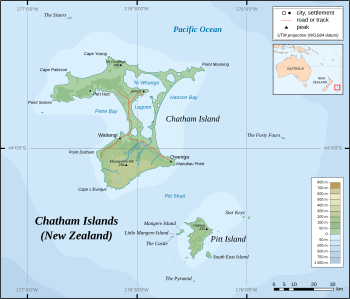Mangere Island facts for kids

Mangere Island (left) and Little Mangere (right)
|
|

Map showing location of Mangere Island
|
|
| Geography | |
| Coordinates | 44°16′10″S 176°17′40″W / 44.2695°S 176.2945°W |
| Archipelago | Chatham Islands |
| Area | 1.13 km2 (0.44 sq mi) |
| Highest elevation | 292 m (958 ft) |
| Highest point | Whakapa |
| Administration | |
| Demographics | |
| Population | 0 |
Mangere Island is a small island that belongs to the Chatham Islands. This group of islands is about 800 kilometers (500 miles) east of New Zealand's South Island. Mangere Island covers an area of 113 hectares (280 acres). It is located off the west coast of Pitt Island. The main town in the Chatham Islands, Waitangi, is about 45 kilometers (28 miles) to the south-east on Chatham Island.
Contents
Island Formation and Features
Mangere Island and a nearby island called Tapuaenuku (also known as Little Mangere) are what's left of a very old volcano. This volcano was active during a time called the Pliocene epoch, which was millions of years ago. Over a long time, wind and water have worn down the volcano, leaving these two islands.
Whakapa: The Island's Highest Point
The highest point on Mangere Island is a place called Whakapa. It stands 292 meters (958 feet) above sea level. This makes it the tallest spot on the island.
History of Mangere Island
For a long time, Mangere Island was covered in forests. But in the 1890s, most of the trees were cut down. This was done to make space for sheep to graze.
Animals Introduced and Removed
After the forests were cleared, other animals were brought to the island. Rabbits were introduced, and then cats. Luckily, these animals later died out. This was good for the native wildlife.
Becoming a Nature Reserve
Farmers used Mangere Island for sheep grazing until 1966. Then, the New Zealand government bought the island. It was officially made a Nature Reserve. This means it is a special protected area. The last sheep were taken off the island in 1968.
Island Restoration Efforts
Since 1973, people have been working to restore Mangere Island. This means they are trying to bring it back to its natural state. They are planting native trees and helping native animals return. This work is still going on today.
Bringing Back Native Birds
Many special birds that only live in the Chatham Islands (these are called endemic species) have been brought back to Mangere Island.
- In 1970, the Chatham snipe was reintroduced.
- The black robin came back in 1976.
- The Chatham tomtit was reintroduced in 1987.
- In the 1990s, the shore plover also returned to the island.
These efforts help protect these rare birds and their homes.
See also
 In Spanish: Mangere para niños
In Spanish: Mangere para niños

